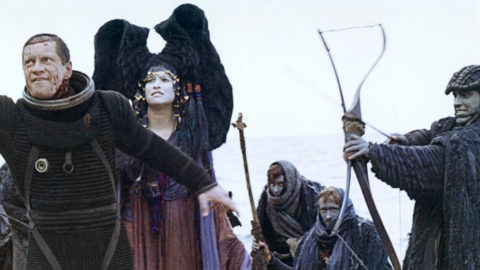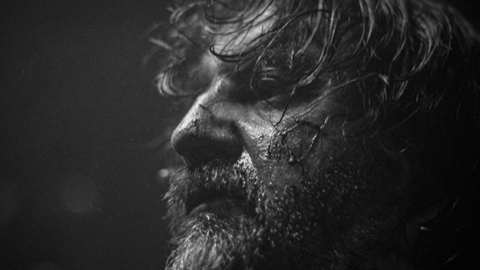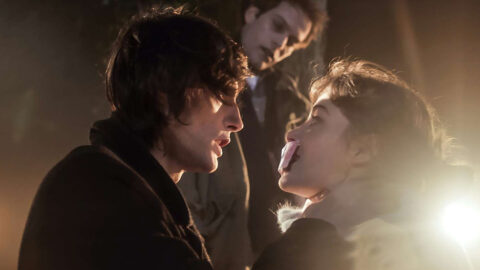Film of the Week: On the Silver Globe
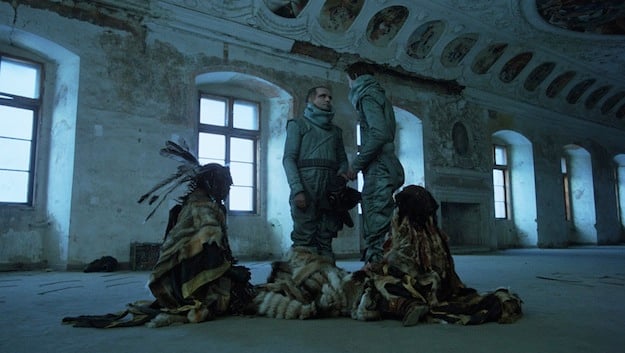
Jean-Luc Godard subtitled his 1967 feature Weekend “a film lost in the cosmos.” But if there’s any film that truly deserves that title, it’s On the Silver Globe, a philosophical epic of science fiction cinema by Polish director Andrzej Zuławski, who died in February this year. On the Silver Globe is the prime film maudit in the oeuvre of a director who pretty much specialized in films maudits—certainly in works that dealt, one way or another, in transgression, transcendence, and excess.
Screening at the Film Society of Lincoln Center in a new digital restoration beginning next week, On the Silver Globe was originally made over a two-year shoot that ended in 1977, but was first seen in 1988 in a version newly supplemented by additional footage and the director’s own voiceover. We hear Zuławski at the start telling us that what we’re about to see is “a shred of a film,” a work of which one fifth is missing, since the film was “murdered.” He’s referring to the fact that, after an extended shoot that took in the Caucasus, the Crimea, the Baltic coast and the Gobi Desert, Poland’s Ministry of Culture shut down the production. Given that the extant four-fifths of Zuławski’s original vision already runs at 166 minutes, including those brief sequences of additional material, what remains is pretty substantial as shreds go—and comprehensively mind-bending. The Ministry may have had various reasons for curtailing production, but it’s not inconceivable that someone there simply thought that another 40 minutes of this stuff might just have been too much for viewers’ sanity.
As it stands, however, On the Silver Globe is an extraordinary film. In some ways, that’s precisely because of its incomplete condition and Zuławski’s attempt to repair the damage by highlighting it—exposing his film’s scars, as it were. His original intention was to adapt the first novel in a science-fiction trilogy written in 1903 by his great-uncle Jerzy Zuławski. The story involves a group of astronauts from Earth who crash on a distant planet resembling our own; while some are killed, the survivors have children and found a new race of humans. These multitudes come to populate the planet, seemingly through sibling incest, but the first generation apparently all springs from one woman, Marta (Iwona Bielska), and one or another male astronaut. To be honest, I’m a little vague on this point, as I am on much of the plot; one man, Tomasz (Leszek Długosz), apparently fathers the first of a line of Tomaszes, but another, Jerzy (Jerzy Trela), also known as the “Old Man,” seems to be regarded by the new humans as their universal father.
It’s hard to tell exactly who’s who in the film, as characters keep changing appearance, rapidly growing hair and beards, and often appearing with their faces covered in mud or paint, in psychedelic color swirls or complex tattoo-style tracings. In any case, the grandiose, mythical tenor of the saga means that Zuławski isn’t interested in character as such, any more than the Old Testament is when it produces its lengthy litanies of who begat whom.
Nor is it always clear exactly what’s going on among the planet’s multitudinous new population: we see several confrontations of crowds with spears and other weapons; evidence of the establishment of different religious factions; and a great deal of mass ritual in assorted imposing locations. These include beaches, forests, and most striking of all, a vast cavernous underground space that’s the setting, at one point, for an orgiastic writhe-in by crowds of naked extras in blue body paint.
About an hour in, a recognizable plot point emerges: the threat presented by indigenous beings, terrifying bird-like creatures named Sherns. Marek (Andrzej Seweryn), a new arrival from Earth, is enlisted by the humans as their destined liberator from Shern domination. As you might expect, everything ends apocalyptically—or rather, continues apocalyptically, since the film starts off cranked up to the maximum, and barely lets up thereafter.
Take the acting style, which can literally be described as histrionic. Many characters here are explicitly referred to as “actors”—acting is apparently a key social role in this new society—and constantly announce that they’re performing. At one point, a woman with a red-painted face bursts out of the crowd of blue nudes, rushes at the camera and asks, “How do you like my acting?” The performances are flamboyantly incantatory or declamatory, as if each actor is addressing an audience positioned somewhere over the brow of yonder hill. Much agonized screaming and mad laughter is called for, as the actors deliver grandly philosophical or religiose discourse. Examples from the subtitles: “One can have roots only if one acts. One who acts has roots!” “I will feel in me your inhuman translucence. I will feel your incomprehensible breath, your absolute coldness.” “Fertile Marta begat thunder with the moon in heaven . . . She returned swept by the flood and begat fishes.” Bear in mind that much of this dialogue is shouted, even screamed, by actors sometimes drenched in blood or standing waist-high in the sea.
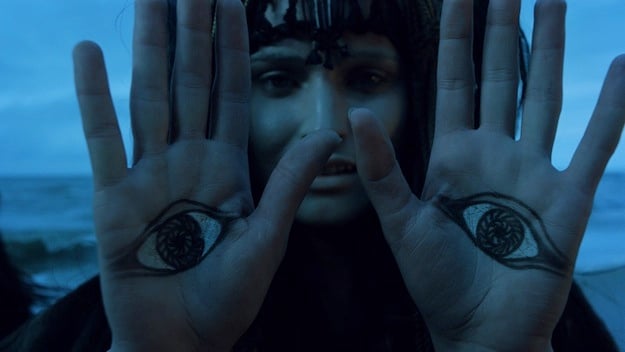
It’s all too easy to make On the Silver Globe sound preposterous, and by most normal criteria it is. It’s relentless, barely modulated: it just goes on and on at never less than full tilt. Yet it’s rarely less than mesmerizing in its strangeness, and in its kinetic intensity. The film is a staggering feat of mise en scène: heaven knows how many hundreds or thousands of extras are involved, most of them accoutred in fanciful costumes by Magdalena Teslawska, redolent of some avant-garde hippie carnival. Characters wear flowing robes, in diaphanous fabrics or rough hessian-like stuff, or extraordinary headdresses, sometimes with massive braided coiffures. There are eclectic ethnographic borrowings—touches of African, Japanese, Native American, and Northern European shaman style, cumbersome constructions of fur and feather. Both clothing and makeup have a remarkable tactility: we become very aware of the texture of rubber, feathers, fabric, prosthetic scars, peeling face paint.
Then there’s Andrzej Jaroszewicz’s extraordinary camerawork, using extreme wide-angle lenses much of the time, and constantly moving. At several points, the hand-held camera bombs headlong through a crowd, coming to a sudden dramatic halt; or simply wheels drunkenly through the action, as at the start, weaving through the rooms of a dilapidated Baroque palace. Generally there’s a disconcerting amount of POV camerawork. In some scenes, we know we’re looking through the eye of an actual camera in the story that is recording the action: now and again, this futuristic recording device appears in the form of a black shiny plate in metallic casing (hats off to Zuławski, then, for inventing the iPhone). We’re constantly reminded that we’re watching cinema.
But On the Silver Globe is theater just as much as cinema: a continual pageant performed in extraordinary locations, in long unbroken takes (bar occasional disconcerting jump-cutting), with the athletic camera operators performing as much as anyone in the cast. The film owes much to the radical spectacular theater of the ’60s and ’70s, and to Artaud’s theories of the Theatre of Cruelty before that. The action is sometimes bacchanalian, very often brutal: there are many sudden slayings, and at one point an unforgettably disturbing crane shot showing people impaled on top of poles some 20 feet high. One of these bodies, at least, is a live actor; you shudder to think how it was done, and wonder that he didn’t succumb to either agonized discomfort or vertigo.
Sections may be missing, but you imagine that the film was always designed to thrive on discontinuity. Even Andrzej Korzynski’s score doesn’t quite make conventional sense: there’s lots of eerie electronica in the first hour, which is then displaced by lush, sometimes euphoric neo-Wagnerian orchestrations, then in the final stretch, a shift to workmanlike rock-blues laced with screaming guitar and bar-band sax.
As for the narrative, it shifts abruptly from episode to episode without much apparent logic. The progression of events makes a nonsense of conventional time spans, as time apparently passes at a different speed on this planet, where people age twice as fast as on Earth. Generations rise and die, while an increasingly hirsute Jerzy eventually resembles Methusaleh’s granddad. Late in the action, Zuławski releases a sudden blast of comic-strip futurism as Krystyna Janda (the icy-faced co-star of Wajda’s Man of Iron) turns up driving a Batmobile-like car across a desert plain, wearing the sort of wide-brimmed hat that Faye Dunaway would have sported in the ’70s.
It’s possible that the film Zuławski originally imagined would have been either unwatchable or unfinishable—which is why you can’t entirely condemn whoever took the decision to stop the shoot, supposedly prompted by its budget overspend. It’s more likely, however, that Poland’s newly strict regime objected both to the film’s excessive imagery and to its attack on repressive political systems, implied by its depiction of religious absolutism (it ends with a crucifixion scene). Reassembling the film in the ’80s, Zuławski supplemented his footage by reading out synopses of unfilmed scenes. These texts don’t, it must be said, contribute that much more coherence, but the fact that they are set to footage of contemporary Poland makes for an arresting poetic complement to the main action. Zuławski gives us shots of forests or mountains, or has his camera race frantically through drab city streets; whenever the voiceover mentions “the planet,” the imagery on screen radically defamiliarizes our own world. This is never more apparent than in a remarkable shot that simply holds on Warsaw subway crowds descending an escalator, all apparently staring in amazement at something just out of sight. They could themselves be aliens, or the future humans of Zuławski’s fiction: an effect of alienation, as it were, similar to the extraterrestrial’s view of everyday Glaswegians in Jonathan Glazer’s recent Under the Skin.
Even with this extra self-reflexive layer, it’s hard to make claims for On the Silver Globe as a great film or even, by conventional criteria, a good one. It’s excessive in so many ways—so grandiose, so hysterical, so utterly earnest. Yet it’s a film you should see, on the big screen if possible, because it’s such a spectacular anomaly—because its sheer will to strangeness is so furiously unrestrained. In its poetic and philosophical aspirations, in its outrageous maximalism, in its utter disregard for the normal prerogatives of pleasing an audience, this is the sort of film that by rights should not even exist. On the Silver Globe is not just a film maudit, but a genuine example of that small but exalted category of films you might call “Impossible Cinema,” in which I’d include other massive visionary projects either completed or aborted: Andrei Rublev; the landscape epics of Miklos Jancsó; Jodorowsky’s unmade Dune, as well as his earlier completed films; Aleksei German’s Hard to Be a God (similar to Silver Globe in its mix of primitivism and futurism); and the supposedly forthcoming Dau, a long-gestating Russian epic of already-legendary don’t-hold-your-breath status.
Strictly speaking, none of these films properly belong in our world, our time, or our cinema. Adhering neither to familiar screen aesthetics nor to the customary logic of filmmaking economics, they present themselves as free-floating lawless bodies, autonomously occupying their own sectors of the filmic cosmos. Some such works are masterpieces, others exotic flowerings of quixotic freakishness—but they all at least propose to redraft cinema’s range of possibilities. In On the Silver Globe, one character declares: “It is not us who are lost in contemplation of the world. It is the world that is lost in contemplation of us.” You can’t help thinking that Zuławski’s film is lost in contemplation of us: staring mad-eyed at its viewers, however few, and daring them to stare back. Whatever you make of On the Silver Globe, you won’t emerge from the confrontation entirely unchanged.
On the Silver Globe opens July 29 at the Film Society of Lincoln Center.



